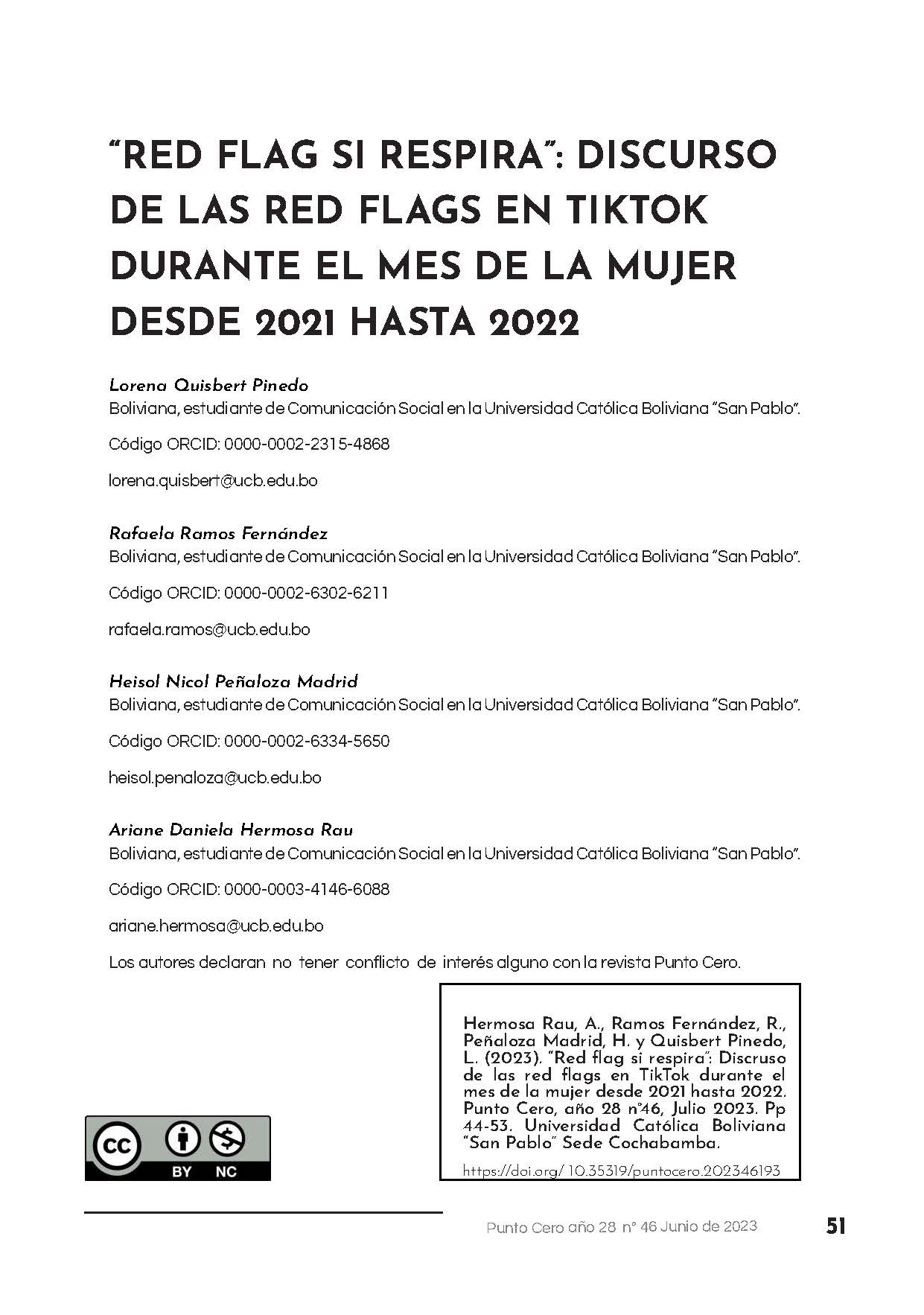“Red flag if it breathes”: Red flags speech on TikTok during the month of women from 2021 to 2022
DOI:
https://doi.org/10.35319/puntocero.202346176Keywords:
red flags, discourse, TikTok, videosAbstract
The term red flag has gained popularity in the last year thanks to the social network TikTok. Being a relatively new term, there is no agreement on what it means or what it specifically refers to. In fact, no research has yet been carried out to study this new phenomenon, especially during the month of March, in which women are celebrated. For this reason, it is important to know and understand how the flag network is conceived and built. This research studies the discourse that is generated around the term “red flag” in videos published during March 2021 and 2022 that have the hashtags #redflags and #8m. The 100 most popular videos published during that time are analyzed. From a mixed approach, it is concluded that the videos are mostly focused on the field of love, that the predominant language is emotional, and that the recipients share the opinions or emotions expressed in the videos.
References
Almazán, M., & Cassab, F. (2020). Ciberactivismo feminista en las estudiantes de la Universidad Autónoma Metropolitana Unidad Xochimilco. Reencuentro. Análisis De Problemas Universitarios, 32(80). https://reencuentro.xoc.uam.mx/index.php/reencuentro/article/view/1060
Barberá, E. (2004). Perspectiva cognitiva-social: Estereotipos y esquemas de género. Psicología y género, 55-80.
Berlanga, I., & Martínez, E. (2010). Ciberlenguaje y principios de retórica clásica: Redes sociales: El caso Facebook—Dialnet. Revista Venezolana de Información, Tecnología y Conocimiento, 7(2), 47-61.
Bryman, A. (2008). Social Research Methods (3era ed.). Oxford University Press.
Cerros, E., & Ramos, M. E. (2009). Discurso de género y emociones en mujeres académicas de alto rendimiento. Perspectivas sociales, 11(1-2), 187-209.
Cervantes, V. (2020). Redes sociales y su influencia en el lenguaje de los jóvenes de 12 a 15 años en la ciudad de Vinces en periodo enero a junio 2020. UNIVERSIDAD TÉCNICA DE BABAHOYO.
Criollo, M. (2020). El discurso político en momentos de campaña electoral. Una aproximación desde el Análisis Crítico del Discurso. RIPS: Revista de Investigaciones Políticas y Sociológicas, 19(1), Art. 1. https://doi.org/10.15304/rips.19.1.6955 DOI: https://doi.org/10.15304/rips.19.1.6955
Durán, M. (2021, agosto 30). TikTok vs Instagram, ¿cuál prefieren los bolivianos? | Los Tiempos. Los Tiempos. https://www.lostiempos.com/oh/tendencias-tecnologia/20210830/tiktok-vs-instagram-cual-prefieren-bolivianos
Guardia, M. (2017). La investigación de procesos interactivos (Segunda edición, Vol. 2).
Hernández, R., & Mendoza, C. P. (2018). Metodología de la investigación: Las rutas cuantitativa, cualitativa y mixta (First edition). McGraw-Hill Education.
Juárez, P. (2021, diciembre 14). Red flag: Qué es y el significado de este término en redes sociales |Glamour.Glamour. https://www.glamour.mx/articulos/red-flag-que-es-significado
Mohsin, M. (2022, abril 3). 10 estadísticas de TikTok. OBERLO. https://www.oberlo.com.mx/blog/estadisticas-tiktok
Osorio, N. (2022, octubre 12). ¿Qué es Ciberactivismo? International Republican Institute. https://www.iri.org/news/que-es-ciberactivismo/?utm_source=www.democracyspeaks.org
Reino, A. (2021, octubre 24). Las plagas de las «red flags» en las redes sociales. rtve. https://www.rtve.es/noticias/20211024/plaga-red-flags-redes-sociales/2199641.shtml
Santander, P. (2011). Por qué y cómo hacer Análisis de Discurso. Cinta de moebio, 41, 207-224. https://doi.org/10.4067/S0717-554X2011000200006 DOI: https://doi.org/10.4067/S0717-554X2011000200006
Van Dijk, T. A. (2009). El discurso como interacción social (3. reimpr). Gedisa.
Vera, M. C. (2021). Análisis del discurso de género en memes como estrategia didáctica para impulsar las habilidades de pensamiento crítico en estudiantes de Estudios de Lengua y Literatura del Programa del Diploma del Bachillerato Internacional. Universidad Central del Ecuador.
Xiaoying, W. (2010). From State Dominance to Market Orientation: The Composition and Evolution of Gender Discourse. Social Sciences in China, 31(2), 150-164. https://doi.org/10.1080/02529201003794924 DOI: https://doi.org/10.1080/02529201003794924

Downloads
Published
How to Cite
Issue
Section
License
Copyright (c) 2023 Revista Punto Cero

This work is licensed under a Creative Commons Attribution-NonCommercial 4.0 International License.








